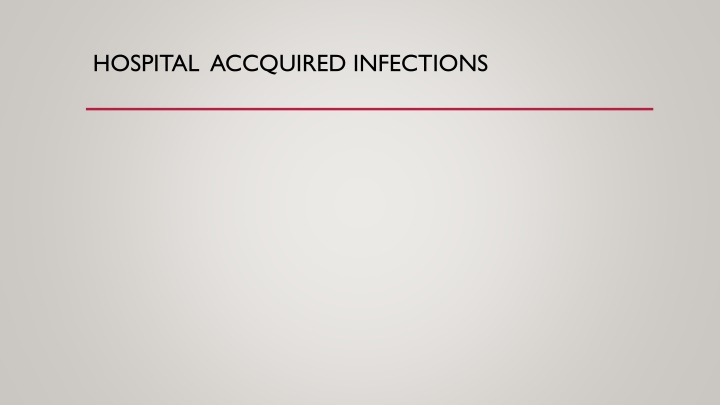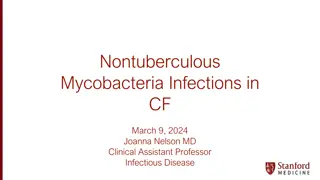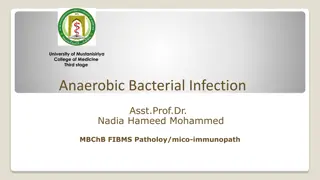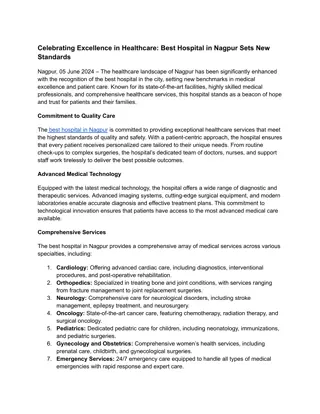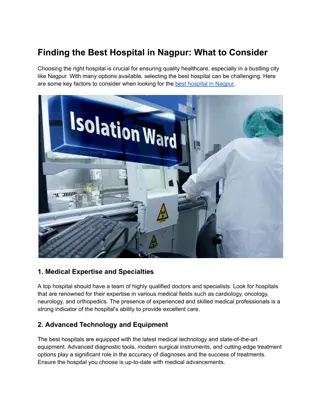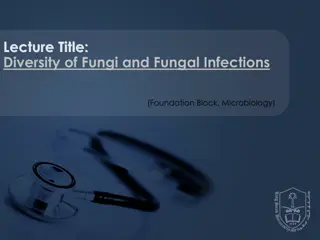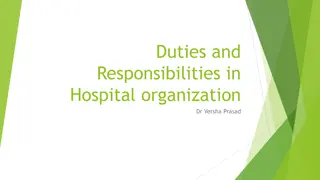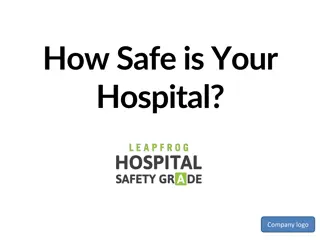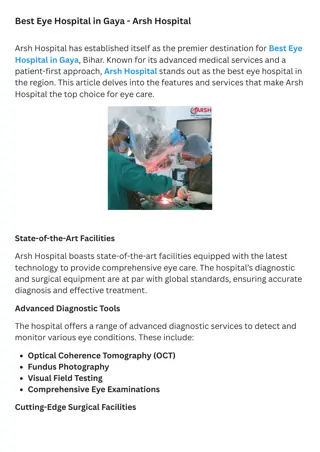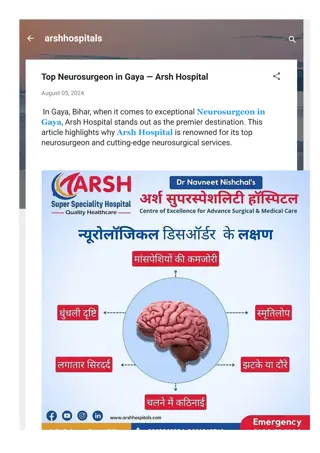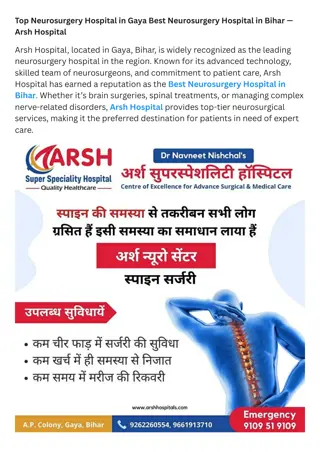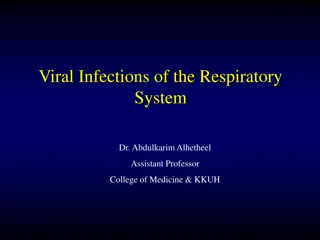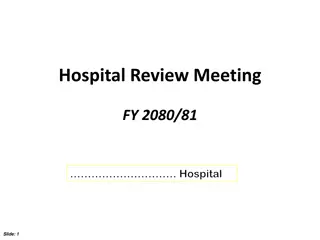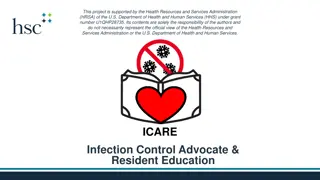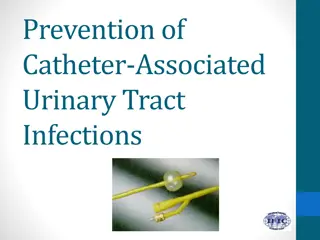HOSPITAL ACCQUIRED INFECTIONS
Hospital-acquired infections (HAIs) are infections that patients acquire during a hospital stay, not present upon admission. Factors affecting HAIs include immune status, hospital environment, organisms, diagnostic/therapeutic interventions, transfusion, and hospital administration. Sources of HAIs include endogenous and exogenous sources like patient flora, environmental sources, healthcare workers, and other patients. Various microorganisms like ESKAPE pathogens and blood-borne infections such as HIV can cause HAIs. Different modes of transmission, like contact, droplet, and airborne, contribute to the spread of hospital-acquired pathogens.
Download Presentation

Please find below an Image/Link to download the presentation.
The content on the website is provided AS IS for your information and personal use only. It may not be sold, licensed, or shared on other websites without obtaining consent from the author.If you encounter any issues during the download, it is possible that the publisher has removed the file from their server.
You are allowed to download the files provided on this website for personal or commercial use, subject to the condition that they are used lawfully. All files are the property of their respective owners.
The content on the website is provided AS IS for your information and personal use only. It may not be sold, licensed, or shared on other websites without obtaining consent from the author.
E N D
Presentation Transcript
HAI DEFINITION Infections acquired in the hospital by a patient: Admitted for a reason other than infection Infection was not present or incubating at admission Symptoms - appear o> 48 hr of admission (for clinical) o2 calendar days (for surveillance) Include oInfections appearing after discharge oOccupational infections among HCWs
FACTORS AFFECTING HAI Immune status Hospital environment Hospital organisms Diagnostic or therapeutic interventions Transfusion Poor hospital administration
SOURCES OF HAIS Endogenous source- patient s own flora Exogenous source o Environmental sources o Health care workers o Other patients
MICROORGANISMS IMPLICATED IN HAIS The ESKAPE pathogens- o Enterococcus faecium o Staphylococcus aureus o Klebsiella pneumoniae o Acinetobacter baumannii o Pseudomonas aeruginosa o Enterobacter species and Escherichia coli
BLOOD BORNE INFECTIONS (BBIS) HIV Hepatitis B Hepatitis C viruses Transmitted by o Blood Transfusion o Needle /Other Sharp Injury /Splash
MODES OF TRANSMISSION OF HOSPITAL-ACQUIRED PATHOGENS. Route Description Contact transmission Direct contact Skin to skin contact ,MC Indirect contact Contaminated inanimate objects such as- Dressings,or gloves,instruments (e.g.stethoscope) Parenteral transmission through- NSI, splashes, saline flush, syringes, vials etc
MODES OF TRANSMISSION OF HOSPITAL-ACQUIRED PATHOGENS. Route Inhalational mode Droplet transmission Description Droplets of >5 m size can travel for shorter distance (<3 feet). Generated while coughing,sneezing,and talking Propelled for a short distance through the air and deposited on the host's body. E.g -bacterial meningitis,diphtheria,respiratory syncytial virus,etc. Airborne droplet nuclei ( 5 m size) or dust particles Remain suspended in the air for long time and can travel longer distance. This is more efficient mode than droplet transmission. E.g. Legionella, Mycobacterium varicella viruses. Airborne transmission tuberculosis, measles and
MODES OF TRANSMISSION OF HOSPITAL-ACQUIRED PATHOGENS. Route Vector Description Via microorganisms Rare mode such as mosquitoes, flies, etc. carrying the vectors Common vehicle such as food,water,medications,devices,and equipment.
MAJOR TYPES OF HAIS Catheter-associated urinary tract infection (CAUTI) Central line-associated blood stream infection (CLABSI) Ventilator-associated pneumonia (VAP) Surgical site infection (SSI).
CATHETER-ASSOCIATED URINARY TRACT INFECTION (CAUTI) Risk factors Advanced age Female gender Severe underlying disease Placement of a urinary catheter for > 2 days.
CAUTI (CONT..) Organisms Gram negative rods -majority of hospital acquired UTIs E.coli is the MC organism implicated. Gram-positive bacteria may also cause UTI S.aureus, enterococci - occasionally cause CAUTI.
CENTRAL LINE ASSOCIATED BLOOD STREAM INFECTION (CLABSI) Organisms o CoNS, and S.aureus Most common o Followed by gram-negative rods and Candida.
CLABSI (CONT..) Risk factors Patient related: oAge (<1 yr and >60 yrs), malnutrition oLow immunity oSevere underlying disease oLoss of skin integrity (burn or bed sore) oProlonged stay in ICUs Device related: presence of central line : multi-lumen, non-tunnelled HCW related: poor IC practices such as HH.
VENTILATOR ASSOCIATED PNEUMONIA Risk factors for VAP Device related: endotracheal intubation Patient related: Prolonged ICU stay leading to colonization of hospital MDROs Aspiration of oropharyngeal flora due to various reasons such as semiconscious state, supine position etc HCW related: poor IC practices such as HH
VAP (CONT..) Organisms: Gram-negative rods such as Acinetobacter species and Pseudomonas Other gram-negative Gram positive bacteria
SURGICAL SITE INFECTIONS (SSI) Definition: Develop at the surgical site within 30 days of surgery Within 90 days for breast, cardiac and joint surgeries) Under reported because 50% of SSIs develop after the discharge.
SSI (CONT..) Organisms Surgical site wounds are classified as clean, clean-contaminated, contaminated or dirty. For clean wound-The skin flora (MC- S.aureus.) For other types- endogenous flora (anaerobes and GNB) in GI Sx.
SSI (CONT) Risk factors for nosocomial wound infection include: o Advanced age, obesity, malnutrition, diabetes o Infection at a remote site that spread through blood stream o Preoperative shaving of the site o Inappropriate timing of prophylactic antimicrobial agent. Note: The antimicrobial prophylaxis is usually given to the patient to prevent the seeding of organisms on the surgical site. It is given 1 hour prior to the incision, usually along with the induction of anesthesia.
PREVENTION OF HAIS The preventive measures for HAIs can be broadly categorized into o Standard precautions o Transmission-based or specific precautions.
STANDARD PRECAUTIONS Set of work practices used to minimize transmission of HAIs. Measures to be used when providing care to/handling o All individuals o All specimens (blood or body fluids) o All needles and sharps
COMPONENTS OF STANDARD PRECAUTIONS Hand hygiene Personal protective equipment Biomedical waste including sharp handling Spillage cleaning Disinfection Respiratory hygiene and cough etiquette
REFRENCES Text book of medical microbiology by AnanthNarayan and Paniker Text book of medical microbiology by D R Arora Text book of medical microbiology by Satish Gupte Text book of medical microbiology by A. S Sastry Text book of medical microbiology by Baweja
